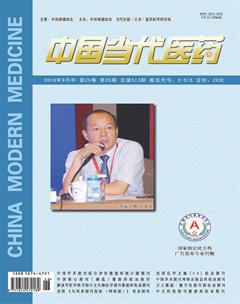3.0T磁共振小肠成像对活动期小肠克罗恩病的诊断价值研究
董丽伟 庄晓曌 王飞 赵应满 李建军 何周桃 陈益耀 蓝程
[摘要]目的 探讨3.0T磁共振小肠成像(MRE)技术对活动期小肠克罗恩病(CD)的诊断价值。方法 选取2015年1月~2017年1月在海南省人民医院住院的23例临床疑似活动期小肠CD患者进行3.0T MRE扫描,分析扫描各时相小肠病变的影像学特点和信号特征。以小肠镜病理活检结果为金标准,分析该扫描方法诊断小肠CD的敏感度和特异度。结果 小肠CD病灶的MRE影像特征为肠壁多发节段性增厚并异常强化,形态固定、信号升高和不均匀、梳状征、肠腔狭窄或扩张;各时相小肠病灶信号强度、肠壁和肠腔改变在平扫和增强之间的差异无统计学意义(P>0.05);MRE诊断小肠CD的敏感度为100%,特异度为83.33%;MRE诊断小肠CD的准确率为95.65%,与小肠镜病理检查比较,差异无统计学意义(P>0.05)。结论 小肠CD病灶在MRE扫描下具有特征性改变,MRE能提高对小肠CD判断的准确率,其特异度有待进一步提高。
[关键词]磁共振小肠成像;克罗恩病;小肠;诊断
[中图分类号] R574.5 [文献标识码] A [文章编号] 1674-4721(2018)9(b)-0004-04
[Abstract] Objective To explore the diagnostic value of 3.0T magnetic resonance enterography (MRE) technology for active small bowel Crohn disease (CD). Methods A total of 23 inpatients suspected with active small bowel CD treated in Hainan People′s Hospital from January 2015 to January 2017 were given 3.0T MRE, Imaging features and signal characteristics of small bowel lesions scanned in different phases were analyzed. The results of pathological examination by enteroscopy were the gold standard, the sensitivity and specificity of the scanning method in diagnosing small bowel CD were analyzed. Results The MRI image features of small intestinal CD lesions were multiple segmental thickening and abnormal enhancement of intestinal wall, morphological fixation, signal elevation and heterogeneity, comb sign, intestinal stenosis or dilatation. There was no significant difference in signal intensity of small intestinal lesions in different phases, intestinal wall and lumen changes between plain scan and enhancement (P>0.05). The sensitivity of MRE in diagnosing small bowel CD was 100%, the specificity was 83.33%. The accuracy rate of MRE in diagnosis of small bowel CD was 95.65%, and there was no significant difference between MRE and enteroscopy (P>0.05). Conclusion The small bowel CD lesions have characteristic changes under MRE scanning. MRE can improve the accuracy rate of judging small intestinal CD, and the specificity needs to be further improved.
[Key words] Magnetic resonance enterography; Crhon disease; Small bowel; Diagnosis
克羅恩病(Crohn disease,CD)是一种原因不明的肠道慢性炎症性疾病,好发于年轻人,病变以末段回肠为主,可累及从口腔到肛门整个消化道的任何部分。双气囊小肠镜和胶囊内镜的临床应用仍受较大限制。计算机断层扫描(computed tomography,CT)和磁共振成像(magnetic resonance imaging,MRI)小肠成像(CT/magnetic resonance enterography,CTE/MRE)目前已经成为小肠影像学检查的主要方法[1-2]。但CT检查的电离辐射越来越受到人们的重视,年轻患者选择CT检查时更应考虑辐射剂量累积的危害。文献报道超过10%的CD患者承受超过有损伤的辐射剂量,即大于50 mSv(相当于5个腹部CT平扫)[3-4]。MRE有其独特的优势:无辐射、良好的软组织分辨力、可多方位成像,能更好地观察肠道炎症和纤维化改变;不仅可观察黏膜,还能分析肠管周围的改变,其临床应用价值逐步显现[5-6]。
1资料与方法
1.1一般资料
选取2015年1月~2017年1月在海南省人民医院住院的临床疑似小肠CD的23例患者为研究对象,年龄18~42岁,平均(30.78±8.08)岁;男18例,女5例;所有患者检查时均处于临床活动期,其中腹痛21例,腹泻17例,腹部包块15例,消化道出血10例,消瘦20例,发热12例;对照组选取健康成人15例,男11例,女4例;年龄20~35岁,平均(27.13±5.49)岁;经小肠钡餐及胶囊内镜检查排除小肠病变。两组的性别、年龄等一般资料比较,差异无统计学意义(P>0.05),具有可比性。本研究在受检者和家属知情的情况下,得到海南省人民医院伦理委员会的审核和批准。
纳入标准:①具备腹泻、腹痛、体重减轻、发热、瘘管、腹腔脓肿、肠狭窄和梗阻、肛周病变等临床表现者;②小肠钡剂造影特征提示小肠病变。排除标准:①肠结核;②肠道肿瘤[7]。
1.2方法
1.2.1肠道准备 检查前3 d禁行胃肠道钡餐检查。检查前2 d中午进无渣半流质饮食(如粥、面、粉汤、鱼、豆腐,不要吃蔬菜、水果、牛奶、蛋类、麦乳精等)。25%甘露醇(湖南科伦制药有限公司,A15110303-1)2000 ml,检查前45 min分4次喝完,每次500 ml。继续喝水3000 ml直至排出清水样大便。检查当天禁食不禁水。受检者扫描前15 min肌内注射东莨菪碱注射液(遂成药业股份有限公司)20 mg(有禁忌证者除外)。
1.2.2 MRE扫描技术参数 扫描序列包括平扫和增强,增强对比剂为钆喷酸葡甲胺盐(Gd-DTPA,北京北陆医药化工公司)增强注药速率2.5 ml/s,注药量15 ml,注射完造影剂后以相同速率加注20 ml生理盐水,动脉期扫描时间设置为注药开始后35 s嘱受检者屏气,启动扫描;80 s再扫静脉期,3~5 min延迟扫描(表1)。
扫描以冠状位为主,横轴位为辅,必要时加扫矢状位。诊断需要时可进行必要的曲面重建扫描,范围上自膈肌,下至耻骨联合。除磁共振扩散加权成像(DWI)外,所有序列要求受检者屏气扫描。
1.3观察指标及评价标准
1.3.1图像分析 MRE图像由两位具有正高职称的MRI诊断医师在不知病理结果的情况下阅片。首先进行图像质量评判,进而分析病灶平扫信号特征和动态增强特征。
1.3.2敏感度和特异度分析 所有患者均行双气囊小肠镜检查。以小肠镜检查获得病理活检结果作为金标准,将MRE诊断的病例与经小肠镜检查和病理证实的病例进行比较,按公式计算其诊断准确率、敏感度和特异度。诊断准确率=(真阳性例数+真阴性例数)/总例数×100%;敏感度=真阳性例数/(真阳性例数+假阴性例数)×100%;特异度=真阴性例数/(真阴性例数+假阳性例数)×100%。
1.4统计学方法
数据采用SSPS 19.0软件进行统计分析,计数资料以率表示,采用χ2检验,以P<0.05为差异有统计学意义。
2结果
2.1图像特征分析
正常健康成人:小肠肠壁厚度<3 mm,厚薄均匀,肠腔无狭窄,肠管与周围组织结构分界清晰,肠系膜血管信号无增强(图1a、图2a);小肠CD患者,男,23岁,因不规则发热伴腹泻、消瘦就诊,MRE图像表现为回肠肠壁多发节段性增厚并异常强化,形态固定、信号升高和不均匀、三壁或三壁征、肠腔狭窄或扩张、部分肠段系膜緣僵硬,形成假憩室样改变,浆膜面毛糙,具有CD肠管典型的“梳状征”(图1b、图2b),经小肠镜病理活检证实为CD;小肠肿瘤患者,男,35岁,因消瘦伴间断黑便2个月余就诊,MRE表现为回肠不规则包块,明显强化(图1c、图2c),手术及病理证实为回肠腺癌。
2.2 MRE不同时相小肠CD病灶信号特征分析
小肠CD病灶在MRE动脉期主要呈现高信号,在静脉期主要呈现低信号或等信号,各时相信号强度在平扫和增强间差异无统计学意义(P>0.05)(表2)。
2.3 MRE小肠CD病变特征
MRE扫描小肠CD病灶主要表现为肠壁增厚,少见肠壁积气强化,肠腔积气或扩张,少见狭窄,肠壁和肠腔改变在平扫和增强间差异无统计学意义(P>0.05)(表3)。
2.4 MRE与小肠镜诊断小肠CD结果的比较
以小肠镜病理诊断为金标准,MRE诊断小肠CD的准确率为(18+4)/23×100%=95.65%,两者差异无统计学意义(χ2=0.138138,P=0.710139)(表4)。
2.5 MRE诊断小肠CD的敏感度和特异度分析
真阳性例数为18例,真阴性例数为5例,假阴性例数为0例,假阳性例数为1例,敏感度=18/(18+0)×100%=100%;特异度=5/(5+1)×100%=83.33%。
3讨论
图像质量的保证是提高小肠CD诊断率的前提[8-9]。在本研究中,肠道准备和扫描参数优化是MRE成像质量的两个关键因素。通常MRE要求检查前进行肠道准备。肠道准备的目的在于使各组小肠充分充盈,保证肠管有效扩张,避免将萎陷状态的小肠误认为病变。其准备方法类似于肠镜检查前的准备,但为了确保扫描质量,MRE肠道准备要求要略高于肠镜,需提前2 d开始准备,小肠中分泌液较多,使用甘露醇作肠道准备以及足量饮水作相当重要[9]。患者小肠病变往往刺激其加快蠕动,会使MRE出现伪影,因此,检查前注射东莨菪碱减少肠蠕动是必须的[10]。另一方面,与普通腹部MRI扫描比较,MRE扫描序列平扫以T1-3D-vibe-fs-cor-P3-bh为主,增强以T2-trufi-cor-bh为主。本研究中所用扫描参数与多数作者的报道类似[11-12]。这些情况较好地保证了MRE的成像质量。
本研究中,MRE能很好地显示小肠的肠壁和肠系膜情况。与正常健康人相比,CD患者的小肠出现一些特征性改变,最明显的是增强扫描时肠壁多发节段性增厚并异常强化,形态固定、信号升高和不均匀、梳状征、肠腔狭窄或扩张、部分肠段系膜缘僵硬,形成假憩室样改变,浆膜面毛糙。95%的CD患者可见肠壁不同程度的增厚,在门静脉期肠壁的显示最为清晰,一般认为肠壁>5 mm即为增厚[13-14]。这些特征与其他作者的报道结果相似[15-16]。MRE还能清晰地显示小肠肿瘤病变,其影像特征不同于CD。与小肠镜活检诊断CD相比,MRE的检出率相似[17]。本研究中,MRE诊断准确率为95.65%,敏感度为100%,特异度则为83.33%。有学者报道MRE诊断小肠CD的敏感度为92.9%~95.8%,特异度为88.79%~95%[18-19],造成这种差异的原因可能与患者个体状况和成像质量有关。对于小肠非特异性炎症,尤其是结核或其他疾病如淋巴瘤等,MRE的特异性还有待提高。
本研究中,MRE小肠CD各时相信号、肠壁和肠腔改变在平扫和增强之间无明显差异。但是,MRE增强扫描能准确评估小肠黏膜外改变、肠外并发症和全面显示小肠、结肠和肛周受累情况,如脓肿、瘘道、系膜增生、淋巴结炎等,为临床提供更多病情的分期分型及临床评价、治疗手段的信息[20-21]。因此,MRE扫描时应该常规进行增强扫描。
MRE对小肠CD的诊断价值,还需要更大样本的临床研究。通过使用更高分辨率的MRI,优化扫描参数,改进小肠相对特异性对比剂等方法[22-23],其价值将获得更大的提升。
综上所述,小肠CD病灶在MRE扫描下具有特征性改变,MRE对小肠CD诊断的准确率与小肠镜检查相当,其特异度有待进一步提高。
[参考文献]
[1]Rosenfeld G,Brown J,Vos PM,et al.Prospective comparison of standard-versus low-radiation-dose ct enterography for the quantitative assessment of Crohn disease[J].AJR Am J Roen-tgenol,2018,210(2):W54-W62.
[2]Yung DE,Har-Noy O,Tham YS,et al.Capsule endoscopy,magnetic resonance enterography,and small bowel ultrasound for evaluation of postoperative recurrence in Crohn′s disease:systematic review and Meta-analysis[J].Inflamm Bowel Dis,2017,24(1):93-100.
[3]Baker ME,Hara AK,Platt JF,et al.CT enterography for Crohn′s disease:optimal technique and imaging issues[J].Abdom Imaging,2015,40(5):938-952.
[4]Park MJ,Lim JS.CT enterography for Crohn′s disease[J].Clin Endosc,2013,46(4):327-366.
[5]Yoon HM,Suh CH,Kim JR,et al.Diagnostic performance of magnetic resonance enterography for detection of active inflammation in children and adolescents with inflammatory bowel disease;a system review and diagnostic meta-analysis[J].JAMA Pediatr,2017,171(12):1208-1216.
[6]Liu W,Liu J,Xiao W,et al.A diagnostic accuracy Meta-analysis of CT and MRI for the evaluation of small boewl Crhon Disease[J].Acad Radiol,2017,24(10):1216-1225.
[7]中華医学会消化病学分会炎症性肠病学组.炎症性肠病诊断与治疗的共识意见[J].胃肠病学,2012,51(12):818-831.
[8]Kosplay M,Guneyli S,Cebeci H,et al.Magnetic resonance enterography with oral mannitol solution:Diagnostic efficacy and image quality in Crohn′s disease[J].Diagn Interv Imaging,2017,98(12):893-899.
[9]Ognibene NM,Basile M,Di Maurizio M,et al.Features and perspectives of MR enterography for pediatric Crohn[J]disease assessment[J].Radiol Med,2016,121(5):362-377.
[10]Macarini L,Stoppinol LP,Centola A,et al.Assessment of activity of Crhon′s disease of the ileum and large bowel:proposal for a new multiparameter MR enterography score[J].Radiol Med,2013,118(2):181-195.
[11]Rimola J,Alvarez-Cofino A,Pérez-Jeldres T,et al.Increasing efficiency of MRE for diagnosis of Crohn′s disease activity through proper sequence selection: a practical approach for clinical trials[J].Abdom Radiol(NY),2017,42(12):2783-2791.
[12]Cullmann JL,Bickelhaupt S,Froehlich JM,et al.MR imaging Crhon′s disease:correlation of MR motility measurement with histopathology in the terminal ileum[J].Neurogastroneterol Motil,2013,25(9):749-e577.
[13]Fujii T,Naganuma M,Kitazume Y,et al.Advancing magnetic resonance imaging in Crohn′s disease[J].Digestion,2014,89(1):24-30.
[14]González-Suárez B,Rodriguez S,Ricart E,et al.Comparison of capsule endoscopy and magnetic resonance enterography for the assessment of small bowel lesions in Crohn′s disease[J].Inflamm Bowel Dis,2018,24(4):775-780.
[15]Kopylov U,Yung DE,Engel T,et al.Diagnostic yield of capsule endoscopy versus magnetic resonance enterography and small bowel contrast ultrasound in the evaluation of small bowel Crohn′s disease:Systematic review and meta-analysis[J].Dig Liver Dis,2017,49(8):854-863.
[16]Kim KJ,Lee Y,Park SH,et al.Diffusion-weighted MR enterography for evaluating Crohn′s disease:how does it add diagnostically to conventional MR enterography?[J].Inflamm Bowel Dis,2015,21(1):101-109.
[17]Kaushal P,Somwaru AS,Charabaty A,et al.MR enterography of inflammatory bowel disease with endoscopic correlation[J].Radiographics,2017,37(1):116-131.
[18]Ohtsuka K,Takenaka K,Kitazume Y,et al.Magnetic resonance enterography for the evaluation of the deep small intestine in Crohnvs disease[J].Intest Res,2016,14(2):120-126.
[19]Moy MP,Sauk J,Gee MS.The role of MR enterography in assessing Crohn′s disease activity and treatment response[J].Gastroenterol Res Pract,2016,2016(1):1-13.
[20]Thomassin L,Armengol-Debeir L,Charpentier C,et al.Magnetic resonance imaging may predict deep remission in patients with perianal fistulizing Crohn′s disease[J].World J Gastroenterol,2017,23(23):4285-4292.
[21]Lunder AK,Jahnsen J,Bakstad LT,et al.Bowel damage in patients with long-term Crohn′s disease,assessed by magnetic resonance enterography and the Lémann index[J].Clin Gastroenterol Hepatol,2018,16(1):75-82.
[22]Quaia E,Sozzi M,Gennari AG,et al.Impact of gadolinium-based contrast agent in the assessment of Crohn′s disease activity: is contrast agent injection necessary?[J].J Magn Reson Imaging,2016,43(3):688-697.
[23]Yoon K,Chang KT,Lee HJ.MRI for Crohn′s disease:Present and future[J].Biomed Res Int,2015,2015:786802.

